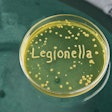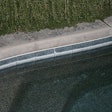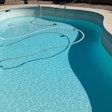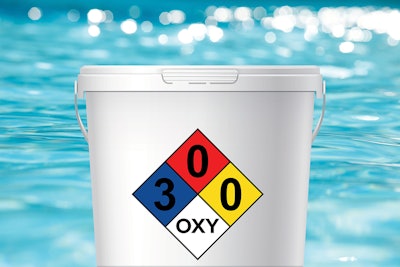
The pool and hot tub industry has a sharp focus on water quality and cannot thrive without safe and healthy water, a goal accomplished to a large extent through the use of chemicals. These chemicals are, typically, shipped in a concentrated form, and can be dangerous; this article discusses practices crucial to handling these chemicals safely. That mission hinges on an understanding of four topics:
- Storage of chemicals
- Usage and handling of chemicals
- Regulatory agencies concerned with chemical safety
- Chemical labeling and transportation in the workplace
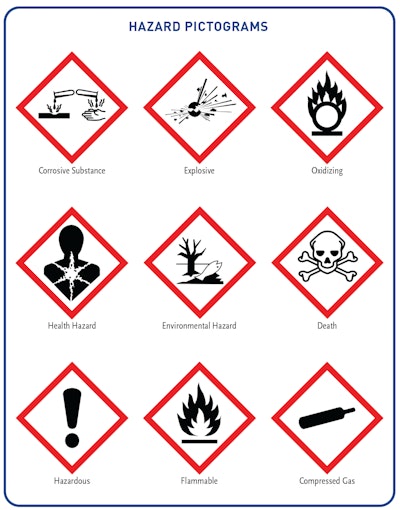
A. Storage of Chemicals
Chemicals should always be stored in a clean, cool, dry, and well-ventilated location. The location must be clean and free of clutter, as a small spill could result in unexpected chemical reactions, such as a fire or release of toxic fumes. Most chemicals have a longer shelf life at lower temperatures, so a cool storage location is recommended. Moisture in a storage location can also lead to deterioration of chemicals and their labels on containers. Deterioration not only changes chemical appearance but could also cause a chemical reaction. Some chemicals, such as oxidizers, will slowly release fumes, requiring the facility to have proper ventilation to minimize any problems associated with these fumes.
The area in which the chemicals are stored needs to allow for physical separation of all different chemicals.
- Liquid chemicals should not be stored near dry chemicals. Especially do not store liquid chemicals above dry chemicals. A leak could lead to a hazardous reaction. Do not store different types of oxidizers next to each other. Calcium hypochlorite (Cal Hypo), dichloro-s-triazinetrione (Dichlor), and trichloro-striazinetrione (Trichlor) can react violently with each other.
- For the residential pool or hot tub owner, keep pool chemicals away from pool equipment — especially pool heaters. The heat from equipment can lead to degradation of chemicals, or worse.
- Also, keep pool chemicals away from flammables as well as lawn and garden chemicals, such as fertilizer, pesticides, and gasoline.
- A dedicated, locked storage area to keep people and animals safe is ideal. Safe storage of chemicals is good for the chemicals and good for those working with or around them.
B. Usage and Handling of Chemicals
When using chemicals to treat pool and hot tub water, there are many safety practices that should be followed.
- Always wear proper personal protective equipment (PPE). This includes safety glasses and gloves.
- Never mix two chemicals together. An unexpected and potentially violent reaction could occur.
- When using a scoop or other measuring device, be sure it is clean and dry. This will avoid cross-contamination.
- Never combine the same type of old chemicals with a newer lot. The old lot may have degraded, and the mixed lot might not have the specified performance. It also increases the chance of cross-contamination.
- Also, always use the original lid for chemical containers to avoid contamination. Be sure the lids are on tight so that nothing can get in or out.
When treating pool or hot tub water, always add the chemical directly to the pool water, ensuring that the label instructions are followed.
- Spread the chemical evenly across the surface of the pool or spa.
- Do not add the chemical to the pool or hot tub when bathers are in the water.
- If a chemical requires dilution for feeder applications, follow the manufacturer's instructions carefully.
- Always add the chemical to the specified amount of water.
- If a spill occurs, clean the area with copious amounts of water.
Before disposing of a chemical to drains, check local regulations. Many pH-adjusting chemicals and oxidizing sanitizers are restricted from discharging to drains, as they may harm the aquatic environment. When chemical containers are empty, wash with lots of water before disposing of them. This will avoid an unexpected reaction, poisoning, or fire in the waste management system.
Finally, after treating the pool or hot tub water with chemicals, test the water with a test kit. This will ensure the treatment chemical was properly dosed. Remember that test kits contain chemicals and should be handled and stored as discussed above.
C. Regulatory Agencies Concerned With Chemical Safety
The main federal regulatory agency that is concerned with chemical safety is the Occupational Safety and Health Administration (OSHA). States also have U.S. OSHA-affiliated agencies. OSHA's purpose is to ensure a safe and healthy workplace. It regulates the safe use of hazardous chemicals in the workplace. Employers are required to develop a hazardous communication program that includes the training of workers on the safe handling of hazardous chemicals. Another requirement is to make available Safety Data Sheets (SDS) for all hazardous chemicals in the workplace. SDSs contain 16 sections with information on: Identification of Substance, Hazard Identification, Composition, First Aid Measures, Firefighting Measures, Accidental Release Measures, Handling and Storage, Exposure Controls/PPE, Physical and Chemical Properties, Stability and Reactivity, Toxicological Information, Ecological Information, Disposal Consideration, Transport Information, Regulatory Information, and Other Information. Safe storage of hazardous chemicals, as discussed previously, is also required. Employers are also required to supply proper PPE for all employees handling hazardous chemicals. Labeling of hazardous chemicals is also regulated by OSHA.
p>The U.S. Environmental Protection Agency (EPA) is also responsible for regulations related to hazardous chemicals. The U.S. Congress passed a law in 1986, commonly known as SARA Title III. It is the Emergency Planning and Community RightTo-Know Act (EPCRA). This act is all about citizens' right to know about hazardous chemicals in their workplace and communities. It requires the creation of state and local planning for hazardous chemical spills. All facilities manufacturing or handling hazardous chemicals must have a response plan for a hazardous chemical spill. This includes pool and hot tub stores, service companies, and distributors of hazardous chemicals. Some of the pool and hot tub chemicals controlled by SARA Title III are Alum, Ammonia, Calcium Hypochlorite, Gas Chlorine, Hydrogen Peroxide, Muriatic Acid, Sodium Bisulfate, and Sodium Hypochlorite.D. Chemical Labeling and Transportation in the Workplace
Chemical labeling is critical for the safe handling of hazardous chemicals, and labels are designed to allow a person handling a chemical to be able to clearly and rapidly assess the related hazards.
While name, product number, manufacturer, and precautionary statements are important to identify a chemical, there are three things that will immediately identify the hazard of a chemical. These are 1) a pictogram, 2) a signal word, and 3) a hazard statement on a label. Examples of hazard pictograms are shown on this page. A signal word accompanies the pictogram, such as "Danger" or "Warning." An example of a hazard statement is, "May Intensify Fire; Oxidizer." These three elements are also located on the SDS for the chemical. The SDS and the labels must match.
Another labeling found in the workplace is the National Fire Protection Association label, as shown on the opening page of this article. These labels are commonly found in hazardous chemical storage areas. They may be placed on the door to the area or on the wall near the chemical. There are four diamonds with a number rating from 0 to 4. A 0 is a low hazard and a 4 is a high hazard. The four areas are Health, Flammability, Reactivity, and Special. These labels provide rapid identification to first responders of the hazards at that location.
When transporting hazardous chemicals, all of the aforementioned storage precautions also apply. The vehicle area should be clean and dry with adequate ventilation. Keep different chemicals in separate locations, with liquids away from solids. Do not transport damaged containers. Also, be sure the chemical containers are well secured so they don't shift during transport. Because this is a workplace, SDSs are required for all hazardous chemicals. A list of the chemicals is also required. Placards on all sides of a vehicle indicating dry weight over 1,000 pounds are required. A daily vehicle inspection should be completed at the beginning of the work schedule. Be aware that local and state regulations may vary from one location to another.
Conclusion
Safety is everyone's concern. Hazardous situations must be addressed immediately. The most important person for maintaining safety is the person using and storing the chemical. The employer must develop a Hazards Communication (HAZCOM) plan, and employees must follow it. But every individual dealing with hazardous chemicals must be ready and willing to speak up when they spot a hazardous situation.
This article first appeared in the January 2023 issue of AQUA Magazine — the top resource for retailers, builders and service pros in the pool and spa industry. Subscriptions to the print magazine are free to all industry professionals. Click here to subscribe.





























